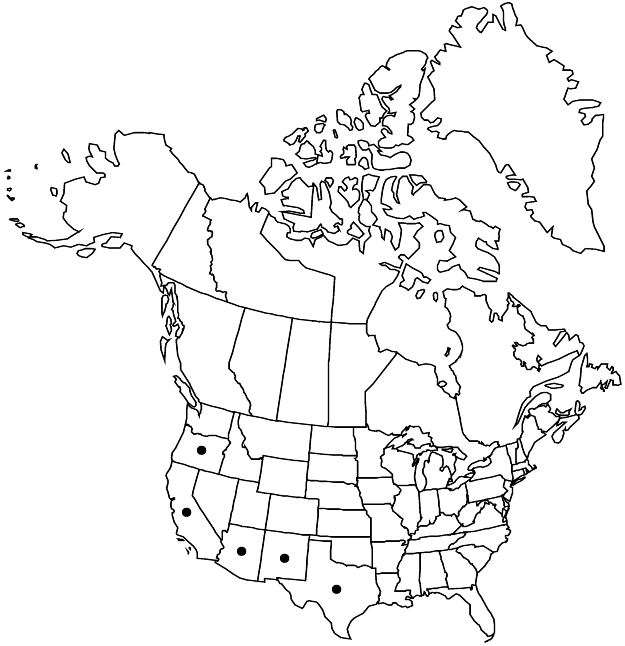Difference between revisions of "Phoradendron villosum"
Boston J. Nat. Hist. 6: 212. 1850.
FNA>Volume Importer |
GeoffLevin (talk | contribs) (Corrected plant diameter and internode lengths based on email message from treatment author.) |
||
| (4 intermediate revisions by 2 users not shown) | |||
| Line 10: | Line 10: | ||
|basionyms={{Treatment/ID/Basionym | |basionyms={{Treatment/ID/Basionym | ||
|name=Viscum villosum | |name=Viscum villosum | ||
| − | |authority=Nuttall | + | |authority=Nuttall |
|rank=species | |rank=species | ||
| − | |publication_title=Fl. N. Amer. | + | |publication_title=in J. Torrey and A. Gray, Fl. N. Amer. |
|publication_place=1: 654. 1840 | |publication_place=1: 654. 1840 | ||
}} | }} | ||
| Line 27: | Line 27: | ||
}}<!-- | }}<!-- | ||
| − | --><span class="statement" id="st-undefined" data-properties=""><b>Subshrubs,</b> erect, to | + | --><span class="statement" id="st-undefined" data-properties=""><b>Subshrubs,</b> erect, to 10 dm diam., dioecious. <b>Stems</b> green or olive green, grayish from pubescence, hairy, hairs stellate, becoming hirtellous to glabrate; internodes terete, 15–38 × 1–3 mm. <b>Leaves</b> green or olive green, grayish from pubescence, stellate-hairy; blade obovate-elliptic to orbiculate, 13–45 × 9–22 mm, thin to thick and fleshy, base subtruncate to acute, apex rounded to acute; basal phyllotaxy transverse. <b>Staminate</b> inflorescences 10–80 mm, stellate-hairy; peduncle with 1 internode, 2–4 mm; fertile internodes 2–5, each (14–)26(–44)-flowered, triseriate, becoming irregular, flowers 2–7 per column. <b>Pistillate</b> inflorescences 10–80 mm, stellate-hairy; peduncle with 1 internode, 2–4 mm; fertile internodes 2–3, each (6–)11(–24)-flowered, triseriate, flowers 1–4 per column. <b>Flowers</b>: petals 3–4, 1 mm. <b>Berries</b> white to pink, oblong to globose, 3 × 3 mm, puberulent below petals.</span><!-- |
-->{{Treatment/Body | -->{{Treatment/Body | ||
| − | |distribution=w;sw;sc United States;n Mexico. | + | |distribution=Ariz.;Calif.;N.Mex.;Oreg.;Tex.;w;sw;sc United States;n Mexico. |
|discussion=<p>Subspecies 3 (2 in the flora).</p><!-- | |discussion=<p>Subspecies 3 (2 in the flora).</p><!-- | ||
--><p><i>Phoradendron villosum</i> was treated by J. Kuijt (2003) as a synonym of P. serotinum subsp. tomentosum (= <i>P. leucarpum</i> in this treatment), but <i>P. villosum</i> has a different, non-overlapping flowering time, shorter stem internodes, and hairy berries. In addition, <i>P. villosum</i> averages fewer pistillate inflorescence fertile internodes than <i>P. leucarpum</i>. Molecular studies by V. E. T. M. Ashworth (2000, 2000b) showed that <i>P. villosum</i> did not form part of the strongly supported <i>P. leucarpum</i> clade. For these reasons, they are here considered distinct species, as was done by D. Wiens (1964).</p><!-- | --><p><i>Phoradendron villosum</i> was treated by J. Kuijt (2003) as a synonym of P. serotinum subsp. tomentosum (= <i>P. leucarpum</i> in this treatment), but <i>P. villosum</i> has a different, non-overlapping flowering time, shorter stem internodes, and hairy berries. In addition, <i>P. villosum</i> averages fewer pistillate inflorescence fertile internodes than <i>P. leucarpum</i>. Molecular studies by V. E. T. M. Ashworth (2000, 2000b) showed that <i>P. villosum</i> did not form part of the strongly supported <i>P. leucarpum</i> clade. For these reasons, they are here considered distinct species, as was done by D. Wiens (1964).</p><!-- | ||
| Line 62: | Line 62: | ||
|basionyms=Viscum villosum | |basionyms=Viscum villosum | ||
|family=Viscaceae | |family=Viscaceae | ||
| − | |distribution=w;sw;sc United States;n Mexico. | + | |distribution=Ariz.;Calif.;N.Mex.;Oreg.;Tex.;w;sw;sc United States;n Mexico. |
|reference=None | |reference=None | ||
|publication title=Boston J. Nat. Hist. | |publication title=Boston J. Nat. Hist. | ||
|publication year=1850 | |publication year=1850 | ||
|special status= | |special status= | ||
| − | |source xml=https:// | + | |source xml=https://bitbucket.org/aafc-mbb/fna-data-curation/src/2e0870ddd59836b60bcf96646a41e87ea5a5943a/coarse_grained_fna_xml/V12/V12_250.xml |
|genus=Phoradendron | |genus=Phoradendron | ||
|species=Phoradendron villosum | |species=Phoradendron villosum | ||
}}<!-- | }}<!-- | ||
| − | -->[[Category:Treatment]][[Category:Phoradendron]] | + | --> |
| + | |||
| + | [[Category:Treatment]] | ||
| + | [[Category:Phoradendron]] | ||
| + | [[Category:Revised Since Print]] | ||
Latest revision as of 10:10, 8 May 2023
Subshrubs, erect, to 10 dm diam., dioecious. Stems green or olive green, grayish from pubescence, hairy, hairs stellate, becoming hirtellous to glabrate; internodes terete, 15–38 × 1–3 mm. Leaves green or olive green, grayish from pubescence, stellate-hairy; blade obovate-elliptic to orbiculate, 13–45 × 9–22 mm, thin to thick and fleshy, base subtruncate to acute, apex rounded to acute; basal phyllotaxy transverse. Staminate inflorescences 10–80 mm, stellate-hairy; peduncle with 1 internode, 2–4 mm; fertile internodes 2–5, each (14–)26(–44)-flowered, triseriate, becoming irregular, flowers 2–7 per column. Pistillate inflorescences 10–80 mm, stellate-hairy; peduncle with 1 internode, 2–4 mm; fertile internodes 2–3, each (6–)11(–24)-flowered, triseriate, flowers 1–4 per column. Flowers: petals 3–4, 1 mm. Berries white to pink, oblong to globose, 3 × 3 mm, puberulent below petals.
Distribution

Ariz., Calif., N.Mex., Oreg., Tex., w, sw, sc United States, n Mexico.
Discussion
Subspecies 3 (2 in the flora).
Phoradendron villosum was treated by J. Kuijt (2003) as a synonym of P. serotinum subsp. tomentosum (= P. leucarpum in this treatment), but P. villosum has a different, non-overlapping flowering time, shorter stem internodes, and hairy berries. In addition, P. villosum averages fewer pistillate inflorescence fertile internodes than P. leucarpum. Molecular studies by V. E. T. M. Ashworth (2000, 2000b) showed that P. villosum did not form part of the strongly supported P. leucarpum clade. For these reasons, they are here considered distinct species, as was done by D. Wiens (1964).
Subspecies flavum (I. M. Johnston) Wiens, distinguished by its yellow leaf hairs, is found in Coahuila and Durango, Mexico.
Selected References
None.
Key
| 1 | Hairs on young stems, leaf blades, and inflorescences of one type, uniformly distributed and of similar lengths; pistillate inflorescence internodes each (7–)12(–24)-flowered; California, Oregon. | Phoradendron villosum subsp. villosum |
| 1 | Hairs on young stems, leaf blades, and inflorescences of two types, some in dense clusters, relatively longer, others uniformly distributed, relatively shorter; pistillate inflorescence internodes each (6–)8(–12)-flowered; Arizona, New Mexico, Texas. | Phoradendron villosum subsp. coryae |